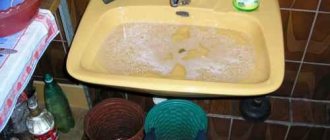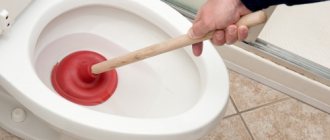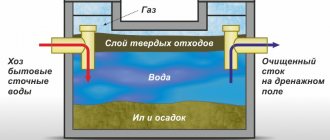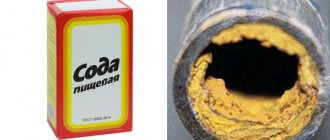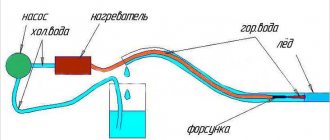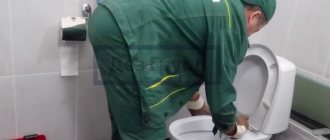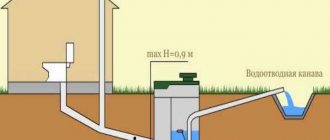How to clean drains in an apartment building.
The solution to this problem is the same.
Air must enter the system so that the water leaves quickly and pipes do not clog. If there is no fan hood, blockages are inevitable. The owner of a private house knows for himself whether he brought the riser to the roof. In a high-rise building, talk to your neighbor on the top floor to see if he removed the fan hood during renovations. What can be done if there is no drain pipe? It still needs to be done. And if this is problematic, then at least install a check air valve. 2. Incorrect operation. An object that should have ended up in the garbage chute got into the riser. Linen, floor rags, plastic bottles, construction waste, etc.
Sewage system in an apartment building: 6 main elements
Two types of sewer blockages There are two types of blockages.
- Industrial blockage. This does not include the passage of sewer pipes in the sewerage system of an apartment building, street, or area.
- Household clog.
This is a blockage of sewer pipes within one apartment or private house.
Any sewer blockage can be eliminated by cleaning the sewer pipes. Sewer cleaning is carried out in various ways depending on the causes and type of blockage.
Sewage system in an apartment building - norms and rules
CHILDREN'S SHOES Ads - STROLLERS Ads - TOYS, BICYCLES Ads - OTHER CHILDREN'S GOODS Ads - SERVICES for CHILDREN Ads - PRODUCTS for MOM The "I'll give it for free" section has moved to the main page (Forum redirection) - Pets in Yaroslavl CATS - general section CATS - health CATS - exhibitions CATS - Place in good hands CATS - Purchase and sale, matings, other commercial offers Active topics about cats (Forum redirection) @@@ DOGS - general section @@@ DOGS - health @@@ DOGS - exhibitions @@@ DOGS - Adoption in good hands @@@ DOGS - Buying and selling puppies @@@ DOGS - Other commercial offers Active topics about dogs (Forum redirection) Aquariums / terrariums Other animals - Work in Yaroslavl VACANCIES (permanent work) VACANCIES (temporary work) RESUME, looking for a job.
Is preventive sewer cleaning standard?
Features of the sewer system in an apartment building2. Repair and cleaning of sewerage: norms and regulations Mostly, citizens of our country live in panel buildings, where the sewerage system in an apartment building is equipped with a built-in type.
The sewer structure must be regularly inspected and repaired, as a result of which many problems can be avoided, such as clogged pipes, flooding, and the appearance of unpleasant odors. Based on this, it becomes clear that preventive maintenance and timely ongoing repairs of the sewer system should be one of the priorities facing not only the utility organizations serving the house, but also the residents themselves.
Where to go and who is to blame
Depending on the emergency situation in the sewer system of an apartment building, you should seek help from the appropriate services:
- the toilet is clogged, the drain pipe has burst, the interfloor sewer riser does not allow waste water to pass through, waste is flooding the basement or the first floors of a residential building - you should immediately contact the housing maintenance office or management company to dispatch a locksmith on duty;
- if wastewater begins to pour onto the surface through sewer wells, you should call Vodokanal, since this is their service area;
- If sewage floods the floor of a residential building, emergency services of utility companies should be called. Telephone numbers are indicated on utility bills.
You should know that passively waiting for a team of specialists to arrive is not welcome. An accident can cause more damage if you don’t do anything yourself.
Therefore, each apartment owner who has discovered signs of an emergency with the sewerage system is obliged to warn other residents about the danger that has arisen and take measures to stop the water supply.
If the sewer is constantly clogged, the reason for this is:
- negligent attitude of utility services to inspections and cleaning of sewer pipes;
- the use of sewerage as a garbage chute by individual residents of a residential building.
Finding the culprits and conducting investigations into the causes of sewer blockage in an apartment building can take a long time.
ATTENTION! Look at the completed sample application to the Prosecutor's Office against the management company due to frequent sewer blockages:
Watch the video. The sewer is clogged, how to clear it:
Cleaning drains in a residential area: why clogs appear
If the sewer system in an apartment or private house is clogged, what should you do to correct the situation and restore the toilet’s functionality? The problem can be solved; sometimes even the owner of the apartment can clean a clogged toilet pipe on his own. But it’s safer to call a competent plumber to prevent the basement from flooding with sewage and flooding your apartment and your neighbors’. Content
- 1 How do clogged sewer pipes manifest?
- 2 Causes of clogging
- 3 How to clear the blockage yourself?
- 4 Cleaning sewer pipes
- 5 Professional sewer cleaning
- 6 Where to go if you have problems with sewerage?
- 7 Preventive measures
- 8 Useful video
How does clogged sewer pipes manifest? Sewage in an apartment or house in the private sector is an important utility system.
Signs of clogged sewer pipes
The first sign of a clogged sewer pipe is the slow flow of water into the system. If you drain clean water and the situation does not change, this is a sure sign that it is necessary to take measures to clean the sewer.
The second sign is the spread of an unpleasant odor throughout the house. If you do not attach importance to this circumstance, you will soon be unable to do without calling the emergency housing and communal services service or the management company.
Does the housing office have the right to turn off water?
Read how to file a complaint with Rospotrebnadzor against the management company here.
What to do if you are flooded by your neighbors, read the link:
Sewer blockage: causes, emergency measures, maintenance
For an apartment building, the external sewer system is the city centralized network (for more details: “How is the sewer system organized in the city - central sewer system with examples”). Since the sewer system is considered an integral element of modern comfortable life, it must be constantly repaired and maintained in working condition.
At the end of the last century, cast iron products were used to create sewer systems in houses. Their main advantage was their strength, but there were also plenty of disadvantages.
Since they had significant weight, their installation was difficult. In addition, the rough inner surface allows all kinds of solid fractions and fats to settle on it. Since cast iron pipes are prone to frequent blockages, their service life is shorter than that of modern plumbing products.
Is sewer pipe cleaning a paid service or not?
All sewer pipes laid horizontally must have a slope of 0.05 (5 cm per meter long). Sewage pipes laid vertically must be installed strictly vertically.
Violation of the slope of the pipes leads to the formation of sedimentary and fatty growths on the inner walls of the pipes. Over time, these growths grow and lead to sewer blockages.
Too large a slope will lead to poor flushing of sewer debris, which also leads to blockages. Important! Water collected in the bowls of household plumbing fixtures should be drained quickly, forming a funnel at the drainage point. Drain funnel after cleaning the sewer Cleaning the sewer in a residential building - how to clear the blockage Cleaning the sewer is the only way to clear the blockage. The blockage is removed depending on its type. We list ways to remove blockages from simple to complex. Using a plunger.
The work is carried out in several stages. First, all drain holes in the apartment are closed. Then a plunger is inserted into the toilet drain, with the suction cup facing down.
The next step is to fill the toilet with water (up to 5 liters). Then you need to push the plunger up and down, also performing rotational movements with the handle. ATTENTION! Before cleaning procedures, it is recommended to pour up to 5 liters of hot water into the toilet hole; it will soften the paper and food waste that clog the pipe.
The cleaning rules are not complicated; it is only important to carry out the process on time, without bringing the situation to a critical point. Mechanical cleaning is an effective method, as is chemical cleaning.
Plumbing service experts recommend pouring a quality cleaning product into the toilet every few months. In this case, problems with the sewerage system will occur very rarely.
How to clean a sewer riser in an apartment building.
In apartments with several bathrooms, two risers are also installed.
The sewer riser collects wastewater from all apartments located from top to bottom, and then discharges it into the sewer well, from where it enters the main line. Further, through a long communications system, which includes several kilometers of pipes, pumping stations and inspection wells, wastewater flows into treatment facilities.
Using this scheme, you can determine whose efforts should resolve problems in the sewerage system. All problems with pipes located in the apartment up to the sewer riser must be resolved by the owner of the premises and eliminated at his own expense.
Clogging of sunbeds up to the first sewer well and risers is eliminated by the organization that services the apartment building, through payments from residents for routine repairs and maintenance of common property.
From it, a sewer pipe (bed) with a diameter of 50 mm passes through the bathroom, receiving outlets from the bathtub and washbasin siphons, and is adjacent to the toilet outlet with a diameter of 100 mm. The toilet outlet, in turn, is connected to the sewer riser.
In apartment buildings over the years, most often to reduce the cost of construction, other sewer system schemes were used. For example, there are houses in which one sewer bed serves two adjacent apartments on the floor at once. In modern houses, more attention is paid to comfort in the layout of apartments, so sewerage may be more complex.
Causes of blockage and their consequences
Attention! The following causes clogging of the sewer system:
- during the construction process, the requirements for installing sewer pipes of the required diameter were violated. That is, the system was installed from pipes of smaller diameter than provided for in the project;
- ordinary wear of pipes as a result of long-term use;
- horizontal sections of the sewer main were laid in violation of technology. That is, the slope at the rate of two centimeters for each meter of pipe was not observed;
- During the installation of the toilet, the solution narrowed the drain, as a result of which the passage of wastewater will be difficult. And this, in turn, will contribute to the systematic clogging of the sewerage system in the apartment;
- violation of the installation of sewer pipes, as a result of which the requirements for tightness of connections are not met. As a result, various debris can enter the sewer system, which will clog the pipe;
- the formation of build-up and deposits as a result of the discharge of fats from dishwashers and kitchen sinks into the drain. Over a long period of operation, such waste constantly accumulates on the walls of the pipes, solidifies and crystallizes. The diameter of the sewer pipe constantly narrows and at a certain time stops passing discharges.
The main reason why sewer clogs occur in an apartment building is the negligence of the residents. The sewer system is designed in such a way that wastewater is discharged through risers from each apartment to the lower part of the house. Subsequently, they move into large-diameter pipelines, which are pumped to treatment plants.
The use of the sewer system as a garbage chute by individual careless residents leads to the fact that it becomes clogged with various rags, household waste, and personal hygiene products.
If the blockage is minor, utility services will deal with it quickly enough. However, it happens that sewage floods the basements of houses and then overflows into the local area. In such cases, the residents of the first floor suffer the most.
If a sewer blockage occurs in an apartment, the wastewater will begin to rise up the riser. As a result, it will begin to flow out of toilets, bathtubs, washbasins and flood the surface of the floors of the apartment.
It will take some time to clear the blockage. However, this will be enough for the wastewater to fill the entire apartment with an unpleasant odor and render the flooring and furniture unusable. And as a result, there is a need for a major renovation of the apartment, replacement of furniture and other unforeseen expenses.
The most effective method for cleaning sewer pipes
All of the above methods can only partially clean the pipe.
- The house began to shrink and the pipes changed slope.
The solution to this problem is the same.
Air must enter the system so that the water leaves quickly and pipes do not clog. If there is no fan hood, blockages are inevitable. The owner of a private house knows for himself whether he brought the riser to the roof. In a high-rise building, talk to your neighbor on the top floor to see if he removed the fan hood during renovations. What can be done if there is no drain pipe? It still needs to be done. And if this is problematic, then at least install a check air valve. 2. Incorrect operation. An object that should have ended up in the garbage chute got into the riser.
How to clean a sewer riser in an apartment building
A blockage between the wells means that the entrance drains enter it, but do not go to the collector. Cleaning according to the current regulations must be carried out pneumatically:
As you know, in our country not all technological operations are carried out in accordance with the regulations. Drain cleaning is no exception. In practice, sewer wire is used for it - steel wire with a diameter of 5 - 6 mm with a hook at one end and a handle at the other.
Cleaning is carried out as follows:
- The coil of wire is completely unwound;
- The mechanic goes down into the well and feeds the wire with a hook to the blockage;
- His partner pulls the wire, preventing it from folding into loops, and rotates the handle, helping the hook break the cork.
This method has four serious disadvantages.
- The walls of the well are always covered with a layer of dried sewage.
Cast iron pipes are mounted as rigidly as possible on the sockets, which prevents the destruction of their seal.
The lezhnevka is equipped with revisions or (in the case of cast iron pipes) plugged tees for cleaning:
- On turns and bends;
- Every 8 meters on straight sections.
These include:
- Inevitable blockages. In addition to rags and grease, the list of causes includes construction debris, sand and cat litter that settle in areas with minimal slope;
When plugs are installed and inspections are closed, blockage of the drainage pipe or outlet to the well leads to flooding of the apartments on the lower floor.
The sewer structure must be regularly inspected and repaired, as a result of which many problems can be avoided, such as clogged pipes, flooding, and the appearance of unpleasant odors. Based on this, it becomes clear that preventive maintenance and timely ongoing repairs of the sewer system should be one of the priorities facing not only the utility organizations serving the house, but also the residents themselves.
If the water from the sink or bathtub begins to drain too slowly, and then stops altogether, then there is only one diagnosis - the sewer is clogged. Cleaning sewer pipes is not a very pleasant task, but it is necessary. And a skilled person can easily cope with it, you just need to handle it correctly...
Usually, when you need to clean a sewer, you immediately remember a sullen plumber in tarpaulin boots with a plumbing cable under his arm. Of course, calling a plumber will save you from having to break through the blockage yourself. But the work of “on-call plumbers” is usually very dirty, and the owners still have to clean up this dirt. Moreover, the cost of the work of a hired specialist is substantial. In large cities, cleaning a sewer in an ordinary standard apartment will cost from 1,500 to 3,000-5,000 rubles, depending on the equipment used and the time frame.
However, in apartments, unlike private houses and cottages, sewer blockages are rarely particularly complex. Knowing the basic principles of the sewer system and the existing cleaning methods , you can deal with almost any sewer blockage in your apartment on your own.
How is the sewer system arranged in the apartment?
The sewer system of a typical apartment in a multi-story building starts from the furthest plumbing fixture - usually a kitchen sink siphon. From it, a sewer pipe (bed) with a diameter of 50 mm passes through the bathroom, receiving outlets from the bathtub and washbasin siphons, and is adjacent to the toilet outlet with a diameter of 100 mm. The toilet outlet, in turn, is connected to the sewer riser .
In apartment buildings over the years, most often to reduce the cost of construction, other sewer system schemes were used. For example, there are houses in which one sewer bed serves two adjacent apartments on the floor at once. In modern houses, more attention is paid to comfort in the layout of apartments, so sewerage may be more complex. It is not uncommon to connect the toilet to the riser with a separate outlet, additional outlets for dishwashers and washing machines, and even two risers are found in apartments with several bathrooms.
The sewer riser collects wastewater from apartments located under each other and discharges it into a sewer well , from where it enters the sewer main . Further, through a complex communications system, including kilometers of pipes, inspection wells and sewage pumping stations, the wastewater flows to treatment facilities.
By the way, using this scheme it is possible to clearly determine who is obliged to remove blockages in the sewer and at whose expense . All problems in the sewer pipes in the apartment up to the sewer riser are the problems of the apartment owner and are eliminated by him independently or at his expense.
Clogging of sewer risers and beds up to the first sewer well is eliminated by the organization that maintains the apartment building , on account of payments from residents for the maintenance and ongoing repairs of common property. Any attempts to collect additional payment for this work are illegal. But this does not relieve residents from liability for gross violations when using sewerage for other purposes. For example, if large rags, accumulations of toilet paper and other foreign objects are found in the sewer riser, the management company can theoretically impose a fine. But in practice this is difficult to do, since it is impossible to identify the specific culprit in a multi-storey building.
Blockages in the sewer line are eliminated by housing and communal services organizations (Vodokanal) to pay for water supply and sewerage. Attempts to collect money for “calling a team” to clean up are illegal. Any claims upon detection of foreign objects can only be submitted to the management company, which can then try to sort things out with the residents.
Why do pipes get clogged?
Clogged sewer pipes are a constant and inevitable process. Sooner or later, everyone faces the need to clean their drains. This occurs due to the gradual accumulation of insoluble components of sewage. The main enemy of sewer pipes is food debris from dishes that come from the kitchen sink. Therefore, blockages in the section of pipe from the sink drain to the bathroom drain are most common.
Remains of food gradually rot into black, greasy sludge with a specific odor. The flow of water when draining carries this sludge through the pipe, spreading the layers on top of each other. Gradually, the lumen of the pipe narrows, and the water stops draining normally. In medical terminology, such a blockage can be called “chronic”. The rate of formation of a “chronic” blockage depends on many factors and can vary from several weeks to tens of years. Sometimes “acute” blockages occur. They are caused simultaneously by large foreign objects (rags, diapers, sanitary pads) and most often occur in the toilet drain.
If “chronic” blockages occur too often, then you should think about the health of the sewer system. Sewage in apartment buildings is free-flowing, and for normal drainage the pipes must have a certain slope towards the riser. For pipes with a diameter of 50 mm, a slope of 3 cm per meter of pipe length is considered normal. A smaller slope will lead to stagnation of wastewater and precipitation of solid particles on the walls of the pipe. A larger slope is also undesirable, since wastewater will flow at high speed along the bottom of the pipe and will not be able to properly wash the entire inner surface, which will also cause blockages.
Therefore, if the slope is insufficient or, even more so, the opposite, then the only solution will be a complete rework of the sewer system. An insufficient or reverse slope can also occur in a properly installed system if plastic sewer pipes sag between the fasteners. In this case, additional fastening of pipes to the wall or floor will help. Plastic pipes are less prone to blockages compared to cast iron pipes, which is why they have now been almost completely replaced.
Frequent “acute” blockages indicate a constant violation of the rules for using the sewerage system. Remember - the less solid waste enters the sewer, the less often it will have to be cleaned. It is especially dangerous, up to the complete replacement of all pipes, to use the sewer system to dispose of the remains of cement or gypsum mortar, various adhesives, including wallpaper.
Methods for cleaning drains
The first impact of wastewater is taken by the siphons of plumbing fixtures - sinks, washbasins, bathtubs. This is where the bulk of the solid particles are initially retained. Therefore, if the water begins to drain more slowly than usual, then you should start with siphons. Cleaning the siphons of the sink and washbasin is simple and does not cause any problems. Cleaning the bathroom siphon is more labor-intensive - it’s simply more difficult to get to. If the siphons are clean, but the water still flows poorly, then you will have to clean the pipes . To do this, you can use washing with boiling water, cleaning with a plunger, cleaning using chemicals, cleaning with a cable or wire, washing with a stream of water, or blowing with air.
Flushing the sewer with boiling water
Flushing sewer pipes with boiling water is the easiest way. It does not require special equipment and effectively cleans pipes of adhering fat. In an ordinary apartment with a sewer pipe 2.5-3 meters long, you will need at least 4-5 liters of boiling water. It's even better to use a solution of soap, washing powder or baking soda. This method is best used for cast iron siphons and pipes ; plastic ones can become deformed due to temperature.
Advantages:
- does not require any tools or equipment
- does not require system disassembly
Flaws:
- can only remove fat and silt “chronic” blockages
- may damage plastic siphons and pipes
Cleaning pipes with a plunger
A plunger is a plumbing tool in the form of a specially shaped rubber cuff attached to a wooden or plastic handle. A plunger allows you to create pressure differences in the sewer pipe that push through the blockage.
Using a plunger is easy:
- the sink or bathtub is filled with water to 8-10 cm
- the overflow hole (if any) is tightly closed with a suitable plug (or the palm of an assistant)
- The plunger is immersed in water, making sure that there is no air left in it, and the drain hole is closed with it
- sharply press the plunger handle several times (5-6), creating a pressure difference in the pipe. The plunger must resist noticeably, dragging masses of water with it
- The last movement is to pull the plunger out of the water, creating a wave of vacuum. In this case, debris may appear from the drain hole.
- if necessary, everything is repeated up to 10-15 times. If after this the blockage is not cleared, then you should try other means.
Advantages:
- can remove fairly complex clogs of any type
- does not require system disassembly
Flaws:
- - not suitable for old, dense blockages
Sewage cleaning using chemicals
This method is based on dissolving the blockage using alkalis or acids . Alkaline products cope well with silt and grease blockages, while acidic ones are effective against blockages made from hair and soap residues. There is no need to list specific products; their composition is almost identical . When using, you should strictly follow the instructions for use and work very carefully. Many substances, when released into the water remaining in the siphon, can boil and splash; also, acidic and alkaline agents can be destructive to the enamel coating of the bathtub. When working with chemicals, it is necessary to wear personal protective equipment - gloves, goggles, protective clothing, and, if necessary, a respirator.
Advantages:
- can remove fairly complex clogs of any type
- does not require system disassembly
Flaws:
- not suitable when the drain is completely blocked
- the substances used can damage both cast iron and plastic pipes, and the enamel of plumbing fixtures (see instructions for use!)
- the substances used are harmful to health
Cleaning pipes with cable or wire
It is better to remove dense fat, silt and mechanical blockages using a plumbing cable or wire . Steel wire with a diameter of 3-4 mm works well if the pipe is straight and there is free space in front of it. An important advantage of the wire is the ability to make a hook at the end and pull out a foreign object from the pipe. The cable is used when there are turns on the pipe and in cramped conditions in front of the pipe.
To access the pipe, the system will have to be disassembled - disconnect the nearest siphon before blockage. The cable or wire is pushed into the pipe, gradually rotating. To do this, the wire needs to be bent at the end, making something like a handle. A plumbing cable always has a handle at the end for rotation. It is convenient for two people to work with a cable or wire - one ensures the rotation of the device, the other feeds it into the pipe. If the cable is stuck, you need to push it back a few centimeters, turn it and continue pushing it. You should be careful with old plastic sewers, especially those with bends . You can accidentally pierce the wall of a plastic pipe somewhere at a bend with a cable.
When the cable is pulled out, a fair amount of dirt ends up on the floor. To prevent this, the cable or wire must be pulled out of the pipe through an old rag . After cleaning with a cable, the pipe must be rinsed with hot water or boiling water.
For more efficient cleaning, cleaning machines . The cleaning machine itself rotates the cable using an electric motor, which allows one person to clean the pipes. The cost of such machines is very high, and using them to clean a sewer pipe 2-3 meters long is hardly justified.
Advantages:
- can remove complex clogs of any type
Flaws:
- requires partial dismantling of the sewer system
Flushing pipes with water
This method is most often used to clean sewer lines or long horizontal pipes coming from private houses and cottages. But, as a last resort, you can also try it for flushing a sewer pipe in an apartment.
Usually, for such washing, a special pump , which supplies hot water under high pressure. For washing small pipes, Karcher-type devices are often used. Hoses and flushing heads are produced specifically for them . The head produces several jets of water that wash away the blockage and remove debris from the pipe. It is difficult to use such a device in an apartment, as it is fraught with a major flood. But if the alternative is to replace all the pipes, then you can work out a trick.
Advantages:
- can remove complex clogs of any type
Flaws:
- requires partial dismantling of the sewer system
- special equipment required
- it is necessary to take measures to collect water drained from the pipe
Blowing pipes with air
A very exotic method, often recommended on the Internet. Given that most city apartment dwellers do not have an air compressor, it is usually suggested to use a blow-out vacuum cleaner. At the same time, various tips are given on sealing the hose in the drain hole using various cuffs and other available materials.
It is very doubtful that any of those advising tried this method in practice. A rare vacuum cleaner can develop a pressure of more than 0.5 atm. Compared to a plunger, which can easily create a pressure difference of 2-3 atm, this is very little. Therefore, if a plunger does not help, then a vacuum cleaner is not worth the trouble.
Advantages:
- “high-tech” method that does not require physical effort
Flaws:
- can break through only the simplest blockages, easily removed by other methods
- Requires hose sealing devices
The most effective way to clean sewer pipes
All of the above methods only partially restore the patency of the pipe. There is enough grease and silt left on the walls, onto which new dirt particles begin to stick. to completely clean the pipes .
To do this, you will need a plumbing cable , a nylon cord with a diameter of 3-4 mm and a metal scourer for washing dishes. After preliminary cleaning and flushing of the pipe, you should try to pass the end of the cable through the pipe and lead it into the toilet. With some skill this is not too difficult to do. Then a nylon cord is tied to the cable, which is pulled through the entire pipe. It turns out to be a sewer pipe strung on a cord. The cord must be stretched so that there is a margin at both ends of at least the length of the pipe.
At the beginning of the pipe, a metal sponge is tied to the cord. The volume of the sponge is selected so that it fits well to the surface of the pipe, but does not get stuck in it. Now all that remains is to stretch this washcloth from the beginning of the pipe to the toilet. If the washcloth gets stuck, the remaining end will allow you to pull it back to the beginning of the pipe. You need to repeat this operation 2-3 times, each time rinsing the pipe with hot water.
After this, the plastic pipe becomes practically new from the inside, and the cast iron pipe is cleaned quite well. Try it - you won't regret it!
What if the pipe is not cleaned?
If you have a severe blockage and you can’t clear the pipe, then it will have to be replaced . The best option is to replace the entire apartment sewer system from the riser. At the same time, it is not difficult to change the cast iron pipes themselves to plastic ones. The main problem is that with such a replacement the finishing of the kitchen, bathroom and toilet suffers greatly.
If you are sure that the blockage, although very strong, is local, then there is a less traumatic way out. You can try to determine the location of the blockage in the pipe and replace only this small area . To do this, a part of the cast iron pipe is cut out with a grinder and an insert is made from a plastic pipe, joining everything together with rubber cuffs.
We recommend reading
- What is an RCD?
- How to make a simple hidden wiring finder?
- How to control lighting from several places?
- How to clean silver at home?
- How to find a good electrician?
- Typical mistakes of unprofessional electricians. Part 1
- Installation of a steel bath. How to do it right?
- Which bathtub is better to buy?
- How to connect wires correctly? Electrical wiring in the apartment
- Ten commandments of a good electrician
Sewage system in an apartment building: 6 main elements
Two types of sewer blockages There are two types of blockages.
- Industrial blockage. This does not include the passage of sewer pipes in the sewerage system of an apartment building, street, or area.
- Household clog.
This is a blockage of sewer pipes within one apartment or private house.
Any sewer blockage can be eliminated by cleaning the sewer pipes. Sewer cleaning is carried out in various ways depending on the causes and type of blockage.
Or one of the household members threw a plastic bag down the toilet.
Any claims when foreign elements are found in the sewer can only be submitted to the management company, which can then deal with the residents.
Why do pipes get clogged?
Clogged sewer pipes are an inevitable and constant process. Sooner or later, everyone is faced with the need to clean their drains. This occurs because insoluble sewage waste gradually accumulates in the system. The main cause of blockages is food debris from dishes coming out through the kitchen sink, so blockages in the area of the system from the sink drain to the bathroom drain can most often be found.
Remains of food gradually rot and turn into greasy black sludge with an unpleasant odor. The flow of water during draining carries the sludge through the pipe, smearing it on the walls. Gradually, the cross-section of the pipe narrows and the water stops draining normally.
Plastic pipes are less prone to blockages compared to cast iron pipes, which is why they have now been almost completely replaced.
Frequent “acute” blockages indicate a constant violation of the rules for using the sewerage system. Remember - the less solid waste enters the sewer, the less often it will have to be cleaned. It is especially dangerous, up to the complete replacement of all pipes, to use the sewer system to dispose of the remains of cement or gypsum mortar, various adhesives, including wallpaper.
Methods for cleaning drains
The first impact of wastewater is taken by the siphons of plumbing fixtures - sinks, washbasins, bathtubs. This is where the bulk of the solid particles are initially retained. Therefore, if the water begins to drain more slowly than usual, then you should start with siphons. Cleaning the siphons of the sink and washbasin is simple and does not cause any problems.
How to clean a sewer riser yourself?
A clogged sewer line is rare, but it does happen. It takes a lot of effort to clog a vertical pipe. If it’s not a cat stuck there (as in the famous joke), then a piece of construction debris or a bunch of rags is certainly present. Residents confused the sewer with a garbage chute. How to clean the riser?
Why is the sewage system clogged in an apartment building?
Clogs are a common plumbing problem. The methods for independently removing blockages in a private and apartment building are not particularly different.
The main reason why water does not flow well in the toilet is the accumulation of fatty deposits on the inner wall of the pipes. Blockage also occurs in the following cases:
- Deterioration of communications.
- Using pipes that are too small in diameter. Such a pipeline will be constantly clogged until the system is brought into optimal condition.
- Incorrect laying technology, as a rule, violates the requirements for pipe slope. Experts recommend maintaining a suitable degree of slope, raising each subsequent meter of pipe by 2 cm.
- Incorrectly installed toilet. The use of cement when installing the product reduces the diameter of the pipe, which increases the risk of blockage.
- Sewer leakage. The system must cope with self-cleaning. Let's say an item of clothing got into it. If the system is tight enough, the item will quickly fly out of the pipe, otherwise it will get stuck for a long time.
Sewage cleaning is more often required when cast iron pipes are installed in the apartment building, which are highly resistant to wastewater. With the appearance of corrosion, roughness and irregularities form on the walls, blocking the flow of water.
Also, water may drain slowly due to a clogged siphon. Before cleaning the pipes, disassemble it and check it.
Blocked riser: symptoms
It’s easy to understand that the riser is clogged:
1. Residents of the top floors have water in all plumbing fixtures. She just doesn't go away.
There is nothing and no one above. Only the attic and roof. Either something was thrown into the sewer vent, or the bird made a nest (which is unlikely).
2. For residents of one of the lower floors, the picture of the blockage looks brighter. Sewage from the neighbors above pours out of the original toilet directly onto the floor.
And, of course, the residents of the upper floors are to blame for this.
Causes and symptoms of sudden blockage
If such a disaster happened, then you should not wait for it to happen again, but change your “bad habits” in time. First, it is better to consider the provocateurs of the problem, and the signs that indirectly or explicitly indicate a sewer blockage.
Causes of congestion
If there is a clogged drain, there are usually quite a few suspects. The following may be to blame for this communal “catastrophe”:
- Large food debris that has become a “lump” in the sewer pipes. Many owners are accustomed to throwing out old preparations, products whose freshness is suspicious, etc. Such treatment is quite capable of causing sudden “constipation.”
- Accumulated paper. We are not talking about toilet, but about its dense variety, especially in large quantities. Magazine or newspaper pages can cause sewer “obstruction”.
- Rags that insidiously elude their owners the moment they empty the bucket of water after washing the floor. But they forget that their “helper” remained there.
- Clumping litter for cat litter boxes. Few people would like to collect such voluminous garbage in bags, so the “cat-loving” owners, without hesitation, send it to free swimming.
- Another type of waste is construction waste. This category includes cement mortar that was left unused, pieces of fallen plaster, plaster, etc.
- Incorrect installation of the pipeline (products of the wrong diameter, non-compliance with the slope), its wear.
- Hair or fur from pets.
Last on the list, but a fairly common culprit is fat that goes down the drain while washing dishes and taking baths. At first, it traditionally accumulates on the walls, then invariably “attracts” other debris to itself. As a result of such a “gathering”, after some time the gap in the pipe becomes tiny.
As a rule, there are no other serious causes of emergency situations. The only fault is the use of communication in a quality not intended for it, that is, the negligent attitude of the residents.
Symptoms of the “disease”
It is not recommended to leave things to chance and hope that the problem will go away on its own over time if some warning signs have appeared. “Showdowns” with the sewerage system should be arranged when:
- An incomprehensibly unpleasant odor appeared in the bathroom (toilet) for no reason. In this case, owners may suspect that something has happened to the drain pipe. With a high degree of probability, problems have arisen with the patency of the riser.
- Cloudy water remaining in the toilet bowl after flushing the tank, in the sink, sink, bathtub. Most likely, this is due to a foreign object that “managed” to remain in the water seal of the plumbing fixture. Or a traffic jam.
- Slow drainage of water after draining. If water first fills the thicket halfway and then reluctantly leaves it, then it is reasonable to assume that a plug of sediment is growing inside the pipe.
If any of these symptoms appear from time to time, then owners must take action. Otherwise, they may soon encounter problems and all the ensuing consequences. More often - in the most literal sense.
Weak points of the sewer system
No systems are perfect. All communications have areas that are subject to constant “attacks” of various, irregular debris. Therefore, the weak points of the sewer system must be considered separately.
- Water seal. This area, located between the outlet and the water surface, is clogged with thick paper, rags, large waste and the same garbage.
- The comb is a horizontal section of pipe; it connects a tee or cross behind the toilet to the sink. Fat deposits often accumulate in this place.
- All available siphons: bathtubs, sinks, sinks, showers. There you can find a whole “garbage collection” - grease, hair, wool, food waste, sand.
- Drain grates, crosses, tees. The first ones collect animal hair and hair, the second ones are successfully blocked with rags.
Sometimes pipes between wells or drains on them become clogged. The last weak name is the bed bugs. These are horizontal sections located between the risers.
Cleaning the sewer riser using special devices
GOST provides for the presence of shaped parts to remove blockages from the sewer:
- inspections (for cleaning risers);
- oblique tees or bends with plugs on horizontal network pipes;
- straight tees with plugs on a vertical pipeline.
The inspection is equipped with a removable flange with a rubber seal. This is a kind of door attached to the bell pipe with bolts.
SNiP requirements regulate the installation locations of revisions:
- on the first and last floors;
- in five-story and higher buildings - every three floors.
Why do we need to know where the revision is? Cleaning of the sewer riser is carried out through it. We are looking for the treasured “door” on the floors located above our own apartment. And we punch a riser through it. Let's start with a flexible steel cable. It should help with minor blockages.
The diagram shows how to clean a sewer riser through the roof of a house.
The steel cable or wire (1) is fed into the riser pipe (2). Slowly and carefully push the tool down. We pass the ceiling (3) and find ourselves in the sewer riser (4). A blockage (6) is detected just below the outlet (5): an obstacle to the movement of the cable is felt.
By twisting the wire, we break through this blockage. We flush the system with water. You can feed it using a hose. If water comes out of the plumbing drain holes, the blockage has not been eliminated. In the diagram, below the floor (7), at the place where the plumbing fixtures are connected to the riser (8), there is another blockage (10).
We take the cable again and repeat the cleaning procedure. When we flush the riser with water, it should not come from the sinks and toilets. The liquid must go into the system.
Kinds
Sewerage is present in every apartment building. Even old residential buildings that did not have normal household amenities are now being restored and supplemented with the necessary utilities.
IMPORTANT! Residents must not only use the systems, but also monitor their condition and operate them correctly, taking into account safety.
A situation where the sewer system is clogged is not uncommon for residents of apartment buildings. And this problem can arise for several reasons. The most common causes of blockage:
- The residents of the residential building themselves are most often to blame for creating such a problem. They often throw large leftovers of food, paper, and other garbage into the toilet, which should go into the trash can.
- The sewer system is not a garbage disposal; it is not designed for such a load. If the pipeline is also old, the inside is covered with a coating of grease, dirt, and various sediments; any debris can cause a blockage. Often, for this reason, the passage in cast iron pipes of the sewer system is blocked.
- Constantly using cold water to wash greasy dishes can cause clogs. Fat accumulates on the walls of the pipeline, the free space gradually shrinks, and the working medium cannot flow normally. And after a while the sewerage turns out to be blocked.
- Fat deposits can be removed using special means, this is not a big problem. But you need to act correctly, not to overdo it with physical force and not to tear off the pipes at their connection.
- An incorrect design for installing a sewer system can also cause a problem. The pipes must be laid at a certain angle, and the connecting elements must be correctly selected.
- If the installation technology is violated, the working fluid of the sewer may not flow directly to the riser, creating blockages and debris deposits. And very quickly such a technical deficiency will manifest itself as stagnation of water in the sinks and toilet.
- Sewage pipes often become clogged after renovations are carried out in an apartment. Remains of building materials (putty, cement, sawdust) are washed into the sewer during cleaning, accumulate there and then block the passage of the working environment. This cause of blockage is considered one of the most difficult, especially if the residues harden and form a dense mass.
- How does the wear of pipes and connecting parts affect the operation of the sewer? Over time, old cast iron pipes lose the smoothness of their internal surfaces, which become rough and retain deposits. This is the cause of blockage that cannot be eliminated on your own. The most likely solution is to replace worn out pipeline elements.
When a blockage occurs in an apartment building, who is to blame? Most often, this is one of the residents who is using the sewage system incorrectly. And less often, this is a technical problem associated with improper laying of pipes or their complete wear. Depending on the cause of the blockage, measures are taken to eliminate it.

